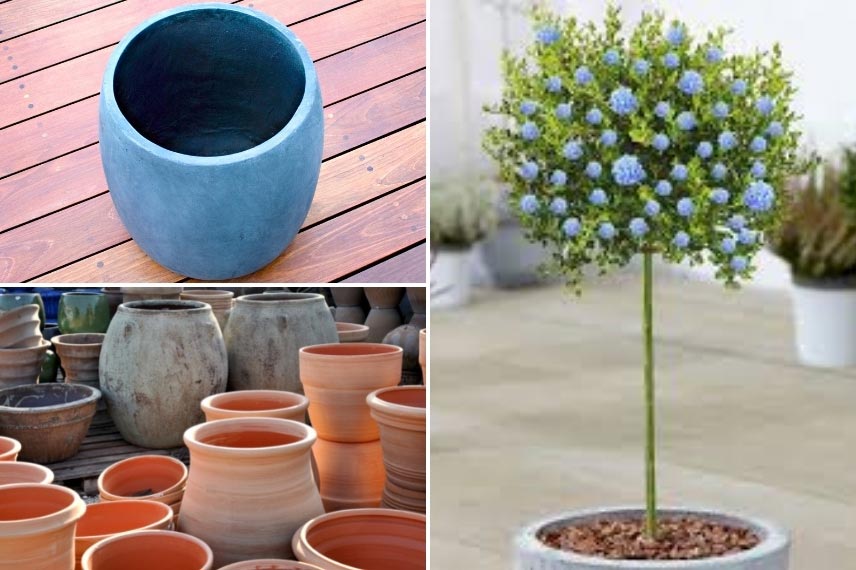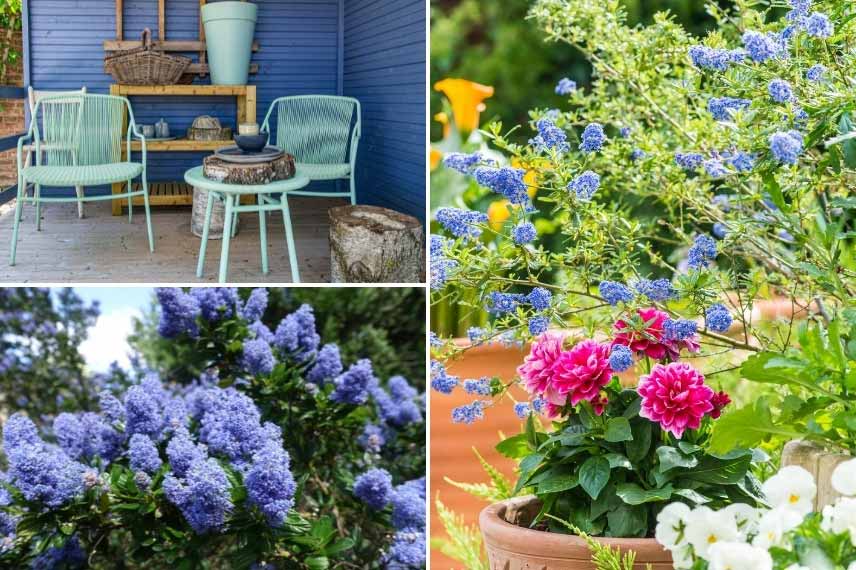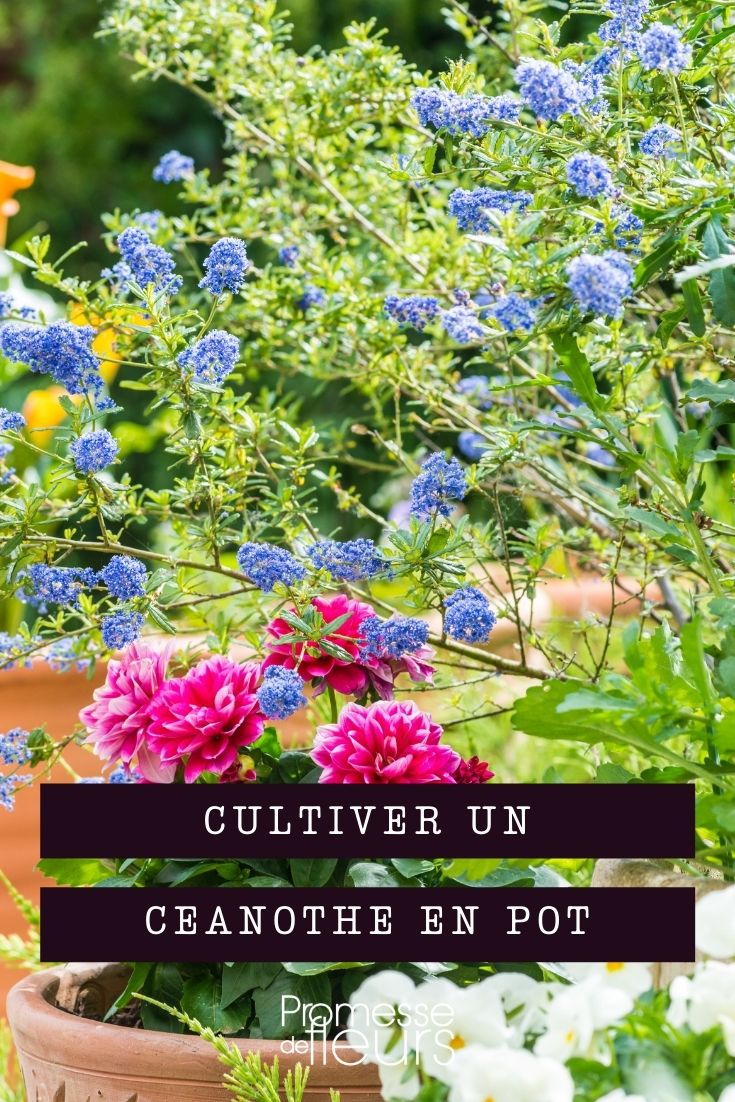
Growing Ceanothus in pots
for stunning blue flowerings
Contents
A marvel when in flower, Ceanothus – also known as California Lilac – can be placed on terraces or balconies, installed in pots or in large containers. The dense foliage of evergreen Ceanothus, with its beautiful glossy green leaves, makes it attractive all year round, but to enjoy its incomparable blue flowering, it will need the right growing conditions and care. We provide valuable tips for growing these magnificent and generous shrubs in pots.
And to learn more, feel free to check our complete guide: “CEANOTHUS, CALIFORNIA LILAC: PLANTING, MAINTENANCE, PRUNING
Which varieties to choose?
There are around 60 species of Ceanothus, often referred to as California Lilac due to their flowering spikes in varying shades of blue, which are delicately fragrant. Shrubs and young plants are mostly evergreen, Mediterranean-type, offering dense, opulent foliage with rather rapid growth.
For pot planting, it is advisable to choose compact species and varieties, as the larger Ceanothus (such as the Ceanothus arboreus ‘Trewithen Blue’, for example) can reach a height of 4m with a spread of 3m… not really suitable for container cultivation!
The most suitable varieties will be:
- Ceanothus prostratus : Flowering bright lavender blue, from April to June – Habit creeping – Height: 40 cm, spread: 2 m – Hardy to -10°C
- Ceanothus thyrsiflorus ‘Repens’ : Flowering sky blue in May-June – creeping habit Height: 1 m, spread: 1.20 m – Hardy to -10°C
- Ceanothus griseus ‘Yankee Point’ : Bright blue flowering from April to June – bushy habit – Height: 1 m, spread: 3 m – Hardy to -10°C
- Ceanothus ‘Italian Skies’ : Dark blue flowering in April-May – bushy habit – Height: 1 m, spread: 2 m – Hardy to -10°C
- Ceanothus (x) ‘Blue Diamond’ : Bright blue flowering in May-June – bushy habit – Height: 90 cm, spread: 1.30 m – Hardy to -10°C
- Ceanothus thyrsiflorus var. repens ‘Blue Sapphire’ : Intense sapphire blue flowering from April to July – spreading habit – Height: 1 m, spread: 1.50 m – Hardy to -10°C
→ With many California Lilacs available, feel free to check our comprehensive article: “Ceanothus: how to choose your California Lilac” to help you select the ones that will suit you best. Also: 5 ceanothus to grow in pots!
Which pot for the Ceanothus?
According to your preferences, choose a tapered or straight terracotta pot, a large wooden trough, or a large planter. Keep in mind that Ceanothus are ground shrubs and not small perennials that thrive in small containers. Their root system must be able to develop in a sufficient volume of soil to provide you with beautiful vegetative masses and an abundant flowering display. Do not be misled by the size of your California lilac at purchase: it will grow in width and height, so it will need the largest pot possible, at least 40 to 50 cm in height and diameter.
Opt for pots made from the most eco-friendly materials, such as terracotta or wood (non-exotic!). These also have the advantage of being more porous and breathable.

Ideal for growing Ceanothus, terracotta allows for various styles of pots, suited to your tastes
Discover other Ceanothus
View all →Available in 1 sizes
Available in 0 sizes
Available in 1 sizes
Available in 3 sizes
Available in 3 sizes
Available in 0 sizes
Available in 1 sizes
Available in 1 sizes
Available in 2 sizes
Available in 1 sizes
What substrate for a potted Ceanothus?
Ceanothus will appreciate well-drained substrates. To improve this drainage, install a layer of gravel or clay balls at the bottom of the pot. You may choose a compost for planters and pots, possibly a lightweight compost for planting on a balcony.
You can also make a mixture composed of equal parts:
- good garden soil
- coarse sand, small gravel, perlite, or any material that does not retain moisture
- compost or potting soil
→ To learn more about substrates, check out our article: “Balcony, terrace and small gardens: composts and fertilisers perfect for small spaces – The latest innovations
Planting Ceanothus in a pot
Planting Ceanothus in a pot or container is done in spring, around April:
- Soak the root ball in water for a few moments
- Place a layer of clay balls or gravel at the bottom of the pot and partially fill it with substrate
- Position the root ball in the pot, with the top of the ball a few centimetres below the rim, and fill in with the remaining substrate. Be sure to gently untangle any root ball that may have formed
- Water
- Apply a mineral mulch or organic mulch on top of the substrate: it will prevent rapid drying and protect the plant in winter

Take care with the various steps of planting so that your Ceanothus thrives in good conditions
Exposure and location
Particularly interesting for its tolerance to air pollution, the California Lilac thrives in urban settings, on a well-exposed terrace or a sunny balcony. Also tolerant of sea spray, it is ideal for a coastal garden or a balcony by the seaside. In any case, it will need sunlight, which is essential for abundant flowering. In the hottest regions, you can also place it in partial shade.
Originating from California, the evergreen Ceanothus prefers areas with mild winters. If there is a risk of frost below -5°C, the potted plant may suffer. It can be stored in a bright, unheated space until conditions improve.

Place your Ceanothus in a pot on a terrace or balcony in the sun or partial shade
Watering potted Ceanothus
Ceanothus are sun-loving shrubs; they thrive in warmth and do not tolerate stagnant moisture at the root level, which is harmful to the plant. The combination of heat and moisture encourages the development of a fungus that attacks the collar, which can be fatal. After planting, provide a generous watering once or twice a week to promote recovery. In summer, water generously only when the soil is dry, spacing out the waterings.
Caring for potted Ceanothus
Ceanothus is a young plant that requires very little maintenance and grows without difficulty. You can lightly prune the stems after flowering to encourage ramification, maintain a compact shape, and refresh it by removing dead wood. For Ceanothus trained on a stem, this pruning will help preserve the plant’s well-rounded silhouette.
In spring and autumn, apply some slow-release fertiliser to compensate for the inevitable depletion of the substrate.
- Subscribe!
- Contents










































Comments